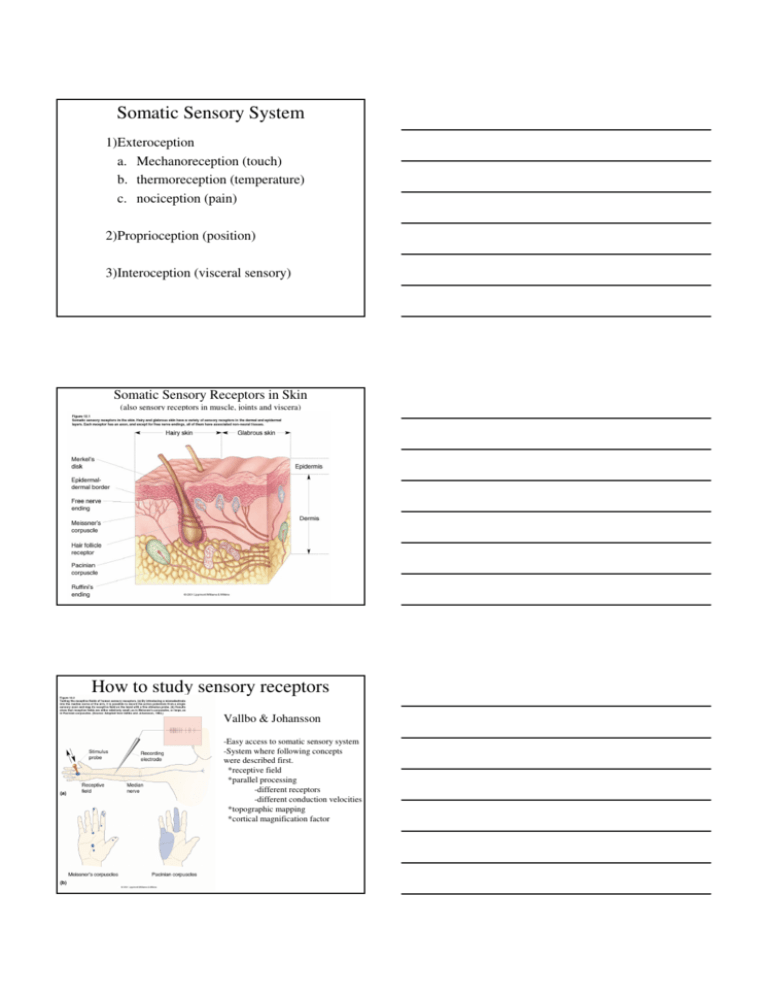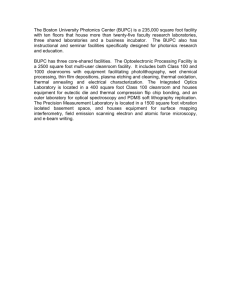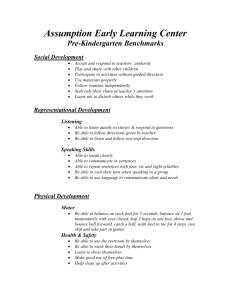
Somatic Sensory System
1)Exteroception
a. Mechanoreception (touch)
b. thermoreception (temperature)
c. nociception (pain)
2)Proprioception (position)
3)Interoception (visceral sensory)
Somatic Sensory Receptors in Skin
(also sensory receptors in muscle, joints and viscera)
How to study sensory receptors
Vallbo & Johansson
-Easy access to somatic sensory system
-System where following concepts
were described first.
*receptive field
*parallel processing
-different receptors
-different conduction velocities
*topographic mapping
*cortical magnification factor
Why is vibration important?
Acuity: two-point discrimination
Acuity on finger 20X better than back
-Receptor density 20X higher
-Receptive field size 20X smaller
-Cortical Magnification 20X greater
Is this the whole story?
Primary Afferents
Segmental Organization of the Spinal Cord and Dermatomes
Assume the Position
Look forward
and this would be
a perfect figure.
What about the face?
Cranial nerveV(trigeminal)
Somatotopy and Magnification
What do we really
care about???
Major Themes
• Are Cortical Maps “Hardwired”
– evidence from training
– evidence from amputation
– phantom limb sensations
• Is Sensory Processing always bottom up?
– (skin-->brainstem-->thalamus-->S1->consciousness
Are Cortical Maps
Static or Plastic?
Remove input (deafferent)
Overstimulate 2 digits
Phantom Limb Sensations
• When a limb is removed patients report that
they still feel sensations in a body part that
is no longer present.
• These sensations can include all modalities:
tactile, tingling, hot and cold, pain, itch and
pleasure.
• Most amputees feel these sensations which
typically diminish with time (although not
always).
• Is there a neurobiological explanation?
Some Case Studies
• Phantom arm felt while shaving
• Excruciating pain felt in phantom foot
during sex.
• Extreme pleasure felt in phantom foot
during sex.
Phantom Limb Sensations
1. No input to foot
area
2. Activity in foot area
still interpreted as
sensation in foot.
From
Genitals
amputation
3. Previously masked
horizontal connections
between neighboring
cortical areas still
receiving input now
activate foot area.
From foot
Phantom Limb Sensations
1. No input to foot
area
2. Activity in foot area
still interpreted as
sensation in foot.
From
Genitals
amputation
3. Previously masked
horizontal connections
between neighboring
cortical areas still
receiving input now
activate foot area.
From foot
Somatotopy and Magnification
What do we really
care about???
Posterior Parietal Cortex
“bringing the pieces together”
-Areas 5 and 7 are classic examples of
association cortex.
-Multiple aspects of a stimulus meld
into a seamless, complete representation
of that object.
-Damage to this area of cortex results in
inability to recognize objects (Agnosia).
-Damage can also lead to hemi-neglect
syndrome where a person ignors the side
of the body and environment that is
contralateral to the lesion.
Posterior Parietal Cortex
Agnosia & Hemi-neglect syndrome
“Mums”
Patricia O’Keefe
Nociception and Pain(Algesia)
An-algesia: no pain
Hyper-algesia: excessive pain
• Nociceptor subtypes
• Hyperalgesia
– Primary & Secondary
•
•
•
•
Fast and Slow Pain
Spinothalamic (or Anterolateral) Pathway
Descending Regulation of Pain
Is pain important? Why do we need pain?
Nociceptor Subtypes
•
•
•
•
mechanical nociceptors
thermal nociceptors
chemical nociceptors
polymodal nociceptors
Hyperalgesia
Primary-at site of damage
Secondary-around site of
damage
(axon reflex and substance P)
(capsaicin story)
Fast and Slow Pain
Sharp, stinging,
local, transient
Dull, aching,
poorly localized, enduring
Nociception = Pain
1. nociceptor activation without pain
2. pain without nociceptor activation
1. Opiates
2. Central Pain
-Phantom Limb
-Neuropathy
Descending Pain Control Pathway








